 To enhance service speed and avoid tariff delays, we've opened a US warehouse. All US orders ship directly from our US facility.
To enhance service speed and avoid tariff delays, we've opened a US warehouse. All US orders ship directly from our US facility.
| Cat. No. | Product Name | Field of Application | Chemical Structure |
|---|---|---|---|
| DC72592 | Zelasudil Featured |
Zelasudil is a Rho-associated coiled-coil kinase (ROCK) inhibitor with a specific binding affinity for ROCK2, a key enzyme in the Rho/ROCK signaling pathway. This pathway plays a critical role in regulating cellular processes such as cytoskeletal organization, cell motility, smooth muscle contraction, and gene expression. By selectively inhibiting ROCK2, Zelasudil modulates these processes, offering therapeutic potential for a variety of diseases characterized by fibrosis, inflammation, and vascular dysfunction, including pulmonary fibrosis, glaucoma, and cardiovascular diseases.
More description
|
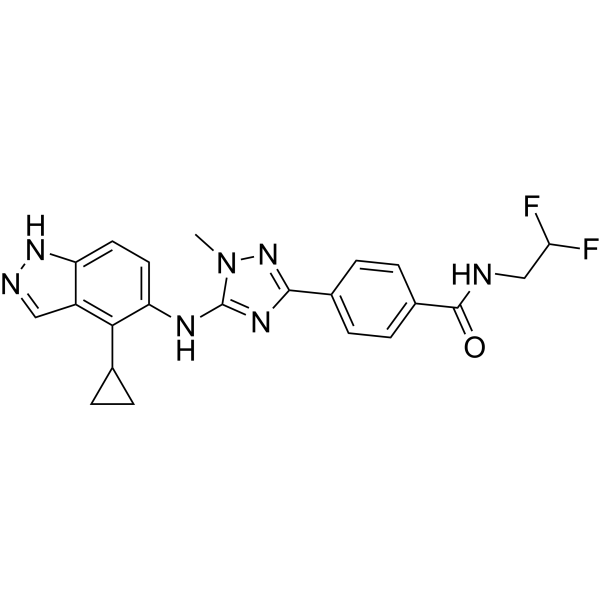
|
| DC10167 | ZINC00881524 Featured |
ZINC00881524 is a ROCK inhibitor.
More description
|

|
| DC73226 | Netarsudil |
Netarsudil (AR-13324) is a potent, selective ROCK inhibitor with Ki of 4.2 nM for ROCK2.
More description
|

|
| DC73225 | ITRI-E-(S)4046 |
ITRI-E-(S)4046 (E(S)4046) is a potent, highly specific, dual synergistic inhibitor of myosin light chain kinase 4 (MYLK4) and Rho-related protein kinase (ROCK) with IC50 of 3.2 nM and 25.6 nM for ROCK1 and MYLK4, respectively.
More description
|

|
| DC73224 | C3TD879 |
C3TD879 is a potent, selective first-in-class Citron kinase (CITK) chemical inhibitor with biochemical IC50 of 12 nM.
More description
|

|
| DC73223 | (S)-BA-1049 |
(S)-BA-1049 is a potent, orally-available ROCK2-selective inhibitor with IC50 of 0.24 uM, 16-fold selectivity over ROCK-1.
More description
|

|
| DC73222 | (R)-BA-1049 |
(R)-BA-1049 is a potent, orally-available ROCK2-selective inhibitor with IC50 of 0.24 uM, 16-fold selectivity over ROCK-1.
More description
|

|
| DC72595 | WF-536 |
WF-536 is an orally active inhibitor of Rho-associated coiled-coil-containing protein kinase (ROCK). WF-536 has tumor anti-metastatic activity. WF-536 can be used for the research of cancer.
More description
|

|
| DC72594 | PT-262 |
PT-262 is a potent ROCK inhibitor with an IC50 value of around 5 μM. PT-262 induces the loss of mitochondrial membrane potential and elevates the caspase-3 activation and apoptosis. PT-262 inhibits the ERK and CDC2 phosphorylation via a p53-independent pathway. PT-262 blocks cytoskeleton function and cell migration. PT-262 has anti-cancer activity.
More description
|

|
| DC72593 | CAY10746 |
CAY10746 is a selective Rho kinase (ROCK) inhibitor. CAY10746 has inhibitory activity for ROCK I, ROCK II with IC50 values of 0.014 μM and 0.003 μM, respectively. CAY10746 can be used for the research of diabetic retinopathy (DR).
More description
|

|
| DC1028 | Y-27632 2HCL Featured |
Y-27632 2HCl is a selective ROCK1 (p160ROCK) inhibitor with Ki of 140 nM.
More description
|

|
| DC6902 | Thiazovivin Featured |
Thiazovivin is a rock inhibitor and enhances fibroblast reprogramming efficiency to generate stem cells
More description
|
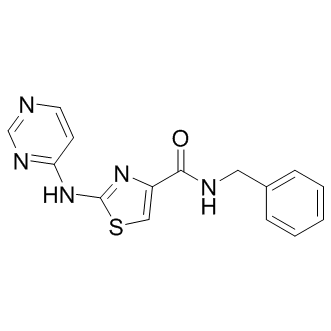
|
| DC7246 | SR3677 Featured |
SR-3677 is a new potent and selective ROCK-II inhibitor with an IC50 of ~3 nM in enzyme and cell based assays; IC50 for ROCK-I is 56 ± 12 nM.
More description
|
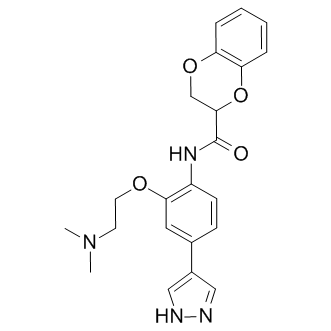
|
| DC8329 | SLx-2119(KD-025,Belumosudil ) Featured |
SLx-2119(KD-025) is a small molecule and selective inhibitor of ROCK2 with IC50 of 105 nM; > 200 fold selecivity over ROCK1(IC50 =24 uM)
More description
|
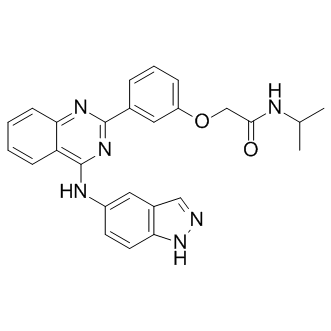
|
| DC9854 | SAR407899 Featured |
SAR407899 is a potent, ATP-competitive ROCK inhibitor woth Ki value of 36 nM/41 nM for human ROCK/Rat ROCK respectively.
More description
|

|
| DC7269 | RKI-1447 Featured |
RKI-1447 is a potent small molecule inhibitor of ROCK1 and ROCK2.
More description
|

|
| DC8831 | RKI-1313 Featured |
RKI-1313 is the negative control for RKI-1447 which is a potent inhibitor of the Rho-associated ROCK kinases with anti-invasive and antitumor activities in breast cancer
More description
|
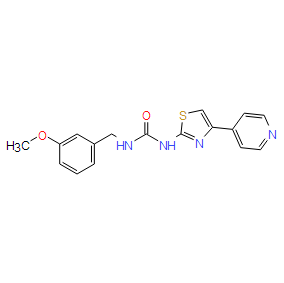
|
| DC7774 | Ripasudil(K-115) Featured |
K-115, an isoquinolinesulfonamide compound, is a highly selective and potent (IC50 = 31 nM) Rho-kinase inhibitor; is in Phase II clinical development in patients with POAG or ocular hypertension.
More description
|

|
| DC9614 | Hydroxyfasudil (hydrochloride) Featured |
Hydroxyfasudil Hcl(HA1100 Hcl), metabolite of Fasudil, is a potent Rho-kinase inhibitor and vasodilator.
More description
|

|
| DC7144 | GSK429286A Featured |
GSK429286A is a selective inhibitor of ROCK1 and ROCK2 with IC50 of 14 nM and 63 nM, respectively.
More description
|
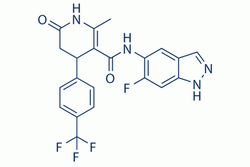
|
| DC7249 | ROCK inhibitor GSK269962A Featured |
GSK269962A(GSK269962) is a potent ROCK inhibitor (IC50 values are 1.6 and 4 nM for recombinant human ROCK1 and ROCK2 respectively); displays greater than 30-fold selectivity for ROCK against a panel of serine/threonine kinases.
More description
|
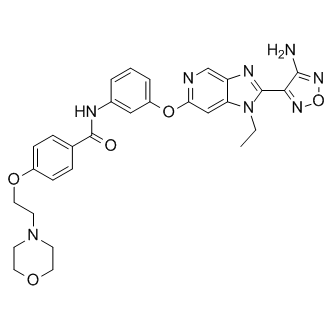
|
| DC72021 | Fasudil hydrochloride semihydrate |
Fasudil (HA-1077; AT877) hydrochloride semihydrate is a nonspecific RhoA/ROCK inhibitor and also has inhibitory effect on protein kinases, with an Ki of 0.33 μM for ROCK1, IC50s of 0.158 μM and 4.58 μM, 12.30 μM, 1.650 μM for ROCK2 and PKA, PKC, PKG, respectively. Fasudil hydrochloride semihydrate is also a potent Ca2+ channel antagonist and vasodilator.
More description
|

|
| DC71495 | WAY-624704 |
WAY-624704 is a novel Rho kinases (ROCK) inhibitor with an Ki of 17 nM.
More description
|

|
| DC49565 | AS1892802 |
AS1892802 is a potent, orally active, and highly selective inhibitor of ROCK. The onset of antinociceptive effect of AS1892802 is as fast as those of Tramadol and Diclofenac. AS1892802 did not induce gastric irritation or abnormal behavior. AS1892802 is an attractive analgesic profile for the research of severe osteoarthritis pain.
More description
|

|
| DC48904 | ROCK2-IN-5 |
ROCK2-IN-5 (compound 1d) is a hybrid compound containing structural fragments of the Rho kinase inhibitor fasudil and the NRF2 inducers caffeic and ferulic acids. ROCK2-IN-5 has good multitarget profile and good tolerability. ROCK2-IN-5 has the potential for thr research of Amyotrophic lateral sclerosis (ALS) with a SOD1 mutation.
More description
|

|
| DC10860 | BDP5290 Featured |
BDP5290 is a potent inhibitor of both ROCK and MRCK with IC50s of 5 nM, 50 nM, 10 nM and 100 nM for ROCK1, ROCK2, MRCKα and MRCKβ, respectively.
More description
|

|
| DC45762 | Y-27632 Featured |
Y-27632 is a selective ROCK1 (p160ROCK) inhibitor with Ki of 140 nM in a cell-free assay, exhibits >200-fold selectivity over other kinases, including PKC, cAMP-dependent protein kinase, MLCK and PAK.
More description
|

|
| DC47897 | Sovesudil hydrochloride |
Sovesudil (PHP-201) hydrochloride is a potent, ATP-competitive, locally acting Rho kinase (ROCK) inhibitor with IC50s of 3.7 and 2.3 nM for ROCK-I and ROCK-II, respectively. Sovesudil hydrochloride lowers intraocular pressure (IOP) without inducing hyperemia.
More description
|

|
| DC8567 | 3-(4-Pyridyl) Featured |
3-(4-Pyridyl)indole is a ROCK-I inhibitor (IC50 = 25 µM) that promotes cell spreading, inhibits membrane blebbing, and induces dissolution of actin stress fibers in a wound healing assay
More description
|

|
| DC46829 | Cotosudil |
Cotosudil is a ROCK kinase inhibitor, which can be used for glaucoma or ocular hypertension research.
More description
|

|